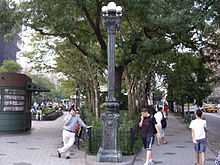Verdi Square

Verdi Square is a small triangle of land enclosed by a railing, located on Manhattan's Upper West Side, between 72nd Street and 73rd Street on the south and north, and Broadway and Amsterdam Avenue on the west and east. On the south the square fronts West 72nd Street; across the street to the south lies Sherman Square. On the north it is enclosed by the Florentine Renaissance palazzo of the Central Savings Bank, now Apple Bank for Savings; the trapezoidal structure, with a vast vaulted Roman banking hall 65 feet high,[1] was designed by York and Sawyer and built in 1926–28.
The 72nd Street New York City Subway station (1 2 3 trains) lies under the square. The entrance to the station in the square is one of only three remaining head houses on the IRT Broadway – Seventh Avenue Line.
History


In the center of Verdi Square stands a monument to opera composer Giuseppe Verdi, erected in 1906.[3] A statue of him by Pasquale Civiletti (1858–1952) stands at the top of it and statues of four of his most famous characters (Falstaff, Leonora of La forza del destino, Aida and Otello) are on the base below him. In the landscaping devised by Lynden Miller in 2004, flowers around the statue bloom in the spring and summer months.[2]
In the 1960s and 1970s Verdi Square and Sherman Square were known by local drug users and dealers as "needle park"[4] as depicted in The Panic in Needle Park (1971). Part of this was due to Verdi Square's location between the 72nd Street entrance to Central Park, which leads directly into Strawberry Fields (long known as a gathering place for illicit behavior), and the 72nd Street entrance to Riverside Park. In addition, some of the subway lines servicing the 72nd Street station make express trips to both Harlem and the Bronx, both of which suffered from rampant crime during the 1960s and 1970s.
A new second entrance head house to the 72nd Street station, completed in 2002, has increased the pedestrian area to the west, taking in a former lane of Broadway traffic. The addition of the new head house has incorporated Verdi Square as part of the pedestrian complex. This, coupled with an increased NYPD presence in the new head house, has decreased the area's popularity among criminals and aided the gentrification of the neighborhood.
In 2006 a group of Upper West Side music lovers in partnership with the New York City Department of Parks and Recreation created the annual Verdi Square Festival of the Arts: a series of three free outdoor September Sunday afternoon concerts presenting young musicians in repertoire ranging from opera to bluegrass. The festival brings music back to a square frequented by Caruso, Chaliapin, Toscanini, the Gershwin brothers and other famous musicians.[5]
References
| Wikimedia Commons has media related to Verdi Square. |
- ↑ Gray, Christopher (April 17, 2005). "73rd and Broadway; At a Landmark Bank Building, Change is in the Air". The New York Times. Retrieved 2008-12-02.
- ↑ 2.0 2.1 Pollak, Michael (January 21, 2007). "Riders on the Storm". The New York Times. Retrieved 2010-05-22.
- ↑ Upper West Side: Verdi Square
- ↑ Shepard, Richard F. (April 8, 1988). "Strolling Up Broadway, The West Side's Spine". The New York Times. Retrieved 2008-04-18.
- ↑ "Verdi Square Festival".
External links
- Verdi Square - New York City Department of Parks & Recreation
- Verdi Square. In a precious corner of West Side the music goes on...,Tiziano Thomas Dossena, Bridge Puglia USA, April 2012
Coordinates: 40°46′44.5″N 73°58′54″W / 40.779028°N 73.98167°W
| ||||||||||||||||||||||||||||||||||||||||||||||||||||||||||||||||||